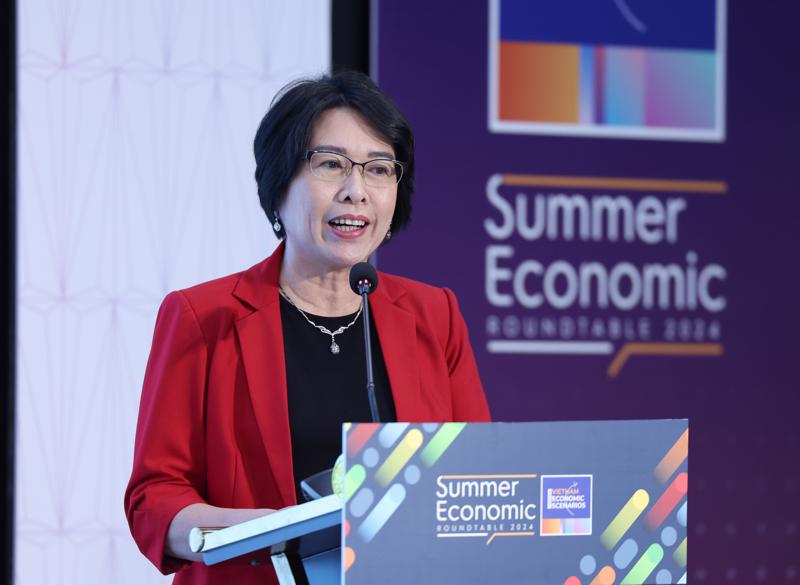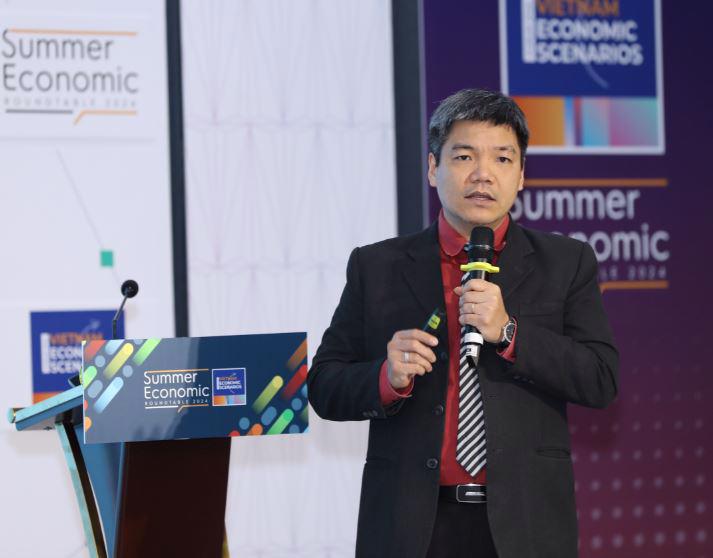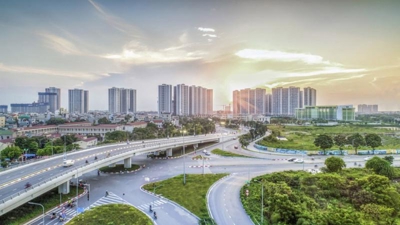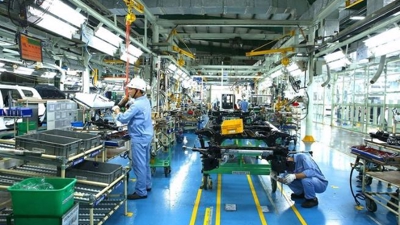Vietnam's economy on firm footing
There is much to like about Vietnam’s first-half economic performance, and while concerns remain there is momentum in place for continued growth over the remainder of 2024.

In an address to the Vietnam Economic Scenario Forum 2024: Summer Economic Roundtable, co-organized on July 11 by the Party Central Committee’s Economic Commission and VnEconomy / Vietnam Economic Times (VET) and with the theme “Vietnam and Next Frontiers for Growth”, Mr. Nguyen Ba Hung, Principal Country Economist at the Vietnam Resident Mission of the Asian Development Bank (ADB), said recent forecasts for Vietnam’s economy reveal relatively high GDP growth compared to other countries in the region.
Vietnam’s growth of around 5-6 per cent may seem relatively low compared to expectations and targets but is quite high regionally-speaking. Together with Vietnam, export-dependent economies like Thailand, Singapore, and Malaysia also experienced sound growth.
According to Mr. Hung, Vietnam is among countries exhibiting a high degree of openness and is closely integrated with regional and global economies, as evidenced by its total bilateral trade equaling 170 per cent of GDP.
Many major economies around the world gained new momentum in the second quarter of 2024 from opportunities to reduce inflation, lower interest rates, and gradually ease monetary policies, along with a resurgence in consumer demand in certain key global markets. In June, international organizations such as the United Nations (UN), the World Bank (WB), the Organization for Economic Cooperation and Development (OECD), and the International Monetary Fund (IMF), provided more optimistic assessments and adjusted global economic growth forecasts upwards by 0.1 to 0.3 percentage points compared to previous projections. This generated momentum for Vietnam’s economic growth in the first half of the year.

at the Vietnam Resident Mission of the Asian Development Bank (Photo: Tri Phong)
Growth recovery
Describing the global economic landscape, Mr. Hung said that, from 2023 to 2026, global growth will continue on a downwards trend, facing ongoing difficulties without yet bottoming out. However, the rate of decline will be slower than previously, when it was impacted by post-Covid concerns, the Russia-Ukraine conflict, and other global strife. While major economies, especially those in North America, Western Europe, and Japan, are experiencing low and slowing growth, the Asia-Pacific region is expected to experience the highest growth prospects, despite also being on a downwards trend.
Regarding inflation, after the surge in 2021-2022 that caused developed countries to tighten monetary policies, inflation is expected to return to normal levels. This trend suggests that monetary easing in high-income economies will likely occur, though the exact timing is uncertain.
Regarding global trade, there are signs of recovery, though it remains weak. Mr. Hung noted that, currently, about one-third of global trade relies on China. However, value chains are shifting due to geopolitical competition (friendshoring), leading to a decrease in relative dependence on China (de-risking).
As for global investment, the main trend is a reduction in the total, with a decline in investment in developing economies and a shift towards developed countries. “FDI into China has decreased by about $150 billion a year; where is this capital going?” Mr. Hung asked. FDI flows have been moving to neighboring countries, with Vietnam remaining a “bright spot” in attracting FDI amid the overall decline. Additionally, Thailand and the Philippines are also attracting significant capital, with Thailand’s FDI doubling in the first quarter of this year and the Philippines recording its highest level in two years in February, taking in $1.4 billion.
Positive prospects
Despite the ongoing challenges in both the global and domestic economies, there are positive signs for Vietnam. According to Mr. Nguyen Duc Hien, Deputy Head of the Party Central Committee’s Economic Commission, GDP growth in the first and second quarters of this year increased from 5.87 per cent to 6.93 per cent, for overall growth of 6.42 per cent in the first half. Key indicators, such as total social investment, public investment, private investment, and FDI saw strong growth. Domestic consumption remained stable, with total retail sales of goods and services growing about 8.6 per cent.
Ms. Tran Thi Hong Minh, Director of the Central Institute for Economic Management (CIEM) at the Ministry of Planning and Investment, is of a similar mind. She noted that Vietnam’s economy achieved remarkable results in the first half of the year. One significant event impacting the global, regional, and Vietnamese economies was the UK’s accession to the Comprehensive and Progressive Agreement for Trans-Pacific Partnership (CPTPP). Additionally, upgraded ASEAN intra-regional free trade agreements (FTAs) had positive effects on Vietnam’s economy in the first half. The country maintained a trade surplus of $11.85 billion, with many improved figures recorded in its import and export activities.
Domestically, Ms. Minh emphasized that timely action had a positive impact on the business environment. The government has been decisive in issuing solutions to boost reforms and create a more favorable business environment. The Prime Minister signed Decision No. 603/QD-TTg on July 8, to establish a Steering Committee to review and address obstacles in the legal framework. On January 5, the government issued Resolution No. 02/NQ-CP, outlining key tasks and solutions to improve the business environment and enhance national competitiveness over the course of 2024. This resolution signaled that improving the business environment is a priority, and ministries and localities have also based specific solutions around it.
Several important laws, such as the Land Law, the Law on Housing, the Law on Real Estate Business, and the Law on Credit Institutions, have been implemented in recent times. These laws demonstrate the government’s determination to continue institutional reforms and make institutions a resource that support business activities and facilitate government operations.
Another positive is the relatively strong recovery of aggregate demand components, with inflation remaining under control after the CPI increased 4.08 per cent. Regarding FDI attraction, Ms. Minh noted that while global attraction has declined, Vietnam posted significant and meaningful figures.
“The foreign investor community still views Vietnam’s investment environment positively,” she told the gathering. “According to information published by the Japan External Trade Organization (JETRO) in May, Vietnam remains the second-most preferred destination for Japanese companies looking to expand their operations.”
Areas of unease
Despite the positive economic outcomes in the first half, Mr. Hien believes that the growth observed in the second quarter, though positive, was uneven and lacks sustainability. There are several issues that need careful analysis and resolution.
He pointed out that compared to the year prior to the pandemic, two-thirds of main economic sectors experienced lower growth rates in the first half, particularly the manufacturing and processing sector. Construction showed promise, with a Purchasing Managers’ Index (PMI) above 50, contributing more to GDP growth. The agricultural sector, considered the “backbone” of the economy, grew only slowly, at some 3.38 per cent. Additionally, major economic growth drivers, including several centrally-managed cities, posted modest and unsustainable growth.
Businesses still face many difficulties, with growth in new enterprises of 8.7 per cent being significantly lower than the 18.5 per cent more enterprises exiting the market. Credit growth across the system reached 4.45 per cent, and while this increased compared to the 3.83 per cent in the same period last year, it remains at its lowest levels for the past decade. “The ability to absorb capital reflects the vitality and expansion capability of businesses, which are still quite limited,” Mr. Hien observed.
Domestic consumption demand has grown but remains weak, coming in at its lowest for the past three years. Exports have improved, but also remain slow.
“Regarding exports and investment, we have commitments to upgrade relations with some strategic partners, but analysis shows that the structure of these market areas is still underdeveloped. What exactly is the problem?” Mr. Hien asked.
Furthermore, while the labor market shows some positive aspects, both the unemployment rate and the underemployment rate have increased. Public investment is primarily utilizing the increased budget revenues from 2023 for transportation infrastructure in 2024, while the proportion of investment in healthcare, education, digital transformation, and digital infrastructure is lower, which is a concern. Several major policy management issues, such as administrative reform, overlapping planning, obstacles related to the science and technology fund, barriers from the Law on Public Investment and the Law on State Budget, and challenges in developing new economic areas like the digital economy and circular economy also need to be clearly analyzed.
Ms. Minh pointed out several internal issues that Vietnam must address. She emphasized the need for measures to ensure that wage increases genuinely benefit workers rather than triggering a wave of price hikes.
“The impact of raising the base salary and the regional minimum wage could lead to cost-push inflation if synchronized solutions are not implemented,” she said. “People are likely feeling this impact keenly, especially in their daily lives. For example, in my area, parking fees have increased by nearly 30 per cent since July. I expect other goods to follow this upwards trend.”
Institutional reforms and improvements to the business investment environment need to be accelerated in the near future. Additionally, one persistent issue, despite the efforts of the government, ministries, sectors, and localities in 2024, is the links between FDI enterprises and domestic enterprises. “I believe more attention should be paid to ensuring that domestic enterprises and FDI enterprises support each other, operate together, and strike a win-win relationship.”
The global economy will continue to face numerous difficulties and uncertainties related to geopolitical and economic instability, she continued, which will certainly impact Vietnam’s economy in the latter half of the year and beyond. When conflicts escalate in the Red Sea, associated costs, especially logistics costs, increase significantly as shipping companies must alter their routes to avoid these conflicts.
The risk of inflation also still looms large. The intensification of trade wars will likely drive up inflation in the US, and the US Fed may maintain high policy rates. Furthermore, Ms. Minh advised businesses to adopt suitable strategies to cope with both domestic and international challenges. This includes strategies for digital transformation, operational changes to anticipate challenges, and a shift towards green production to participate in the global market.







